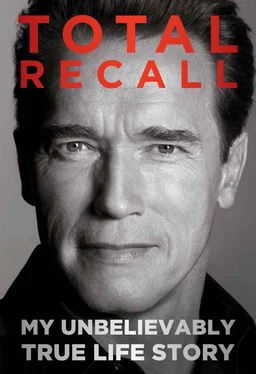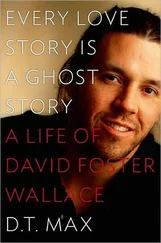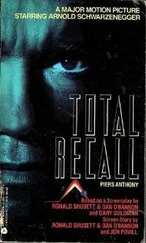In fact, the audiences were much larger in third world countries. A crowd of twenty-five thousand turned out to see Bill Pearl at an exhibition in India, while ten thousand showed up in South Africa. Bodybuilding was one of the most popular spectator sports in the Middle East. A great milestone in Joe Weider’s career came in 1970, when the international community agreed to certify bodybuilding as an official sport. From that point on, bodybuilding programs qualified for state support in dozens of nations where athletics are subsidized.
But I’d been in the United States for four years, and basically nothing had changed. Each big city still had one or two gyms where the bodybuilders would train. The biggest competitions never aimed for more than four thousand or five thousand fans.
This bugged me because I wanted to see bodybuilding thrive, and I wanted to see the athletes and not just the promoters make money. I also felt that if millions of people were going to come to my movies someday, it was very important that they know where the muscles came from and what it meant to be Mr. Universe or Mr. Olympia or Mr. World. So there was a lot of educating to do. The more popular the sport became, the better my chances of becoming a leading man. It was easy for, say, New York Jets quarterback Joe Namath to get into commercials and films. In the major sports—football, baseball, basketball, and tennis—the stars would just cross over and make a lot of money. I knew that would never happen to me. I had to do more. I wanted to promote the sport, both so that more people would take part and to benefit my career.
Joe Weider was pretty set in his ways, though. He didn’t want to try broadening his audience beyond the bodybuilding fans and fifteen-year-old kids—no matter how much I teased. “These are comic books!” I’d say about his magazines. “ ‘How Arnold Terrorized His Thighs’? ‘This Is Joe’s Biceps Speaking’? What kind of silly headlines are those?”
“It sells the magazine,” Joe would say. His approach was to keep the products consistent and take every opportunity to expand their distribution around the world. Probably that was smart, because the business kept growing. But I realized that if I wanted to promote bodybuilding to a new audience, I’d have to find my own way.
I was passing through New York on the way to Europe in the fall of 1972 when I met the two people who would set me on the path: George Butler and Charles Gaines. Butler was a photographer and Gaines was a writer, and they were working as freelancers for Life magazine. They were on their way to cover the Mr. Universe contest that Joe Weider was staging in Iraq. They’d been told that they should talk to me to get background on bodybuilding.
I couldn’t believe my good luck. These were the first journalists I’d ever really talked to from outside the bodybuilding world. They had access to maybe a million readers who’d never heard of the sport. They were about my age, and we hit it off really well. Gaines already knew quite a bit about bodybuilding, it turned out: he’d just published a novel called Stay Hungry, which centered on a bodybuilding gym in Alabama. It was a bestseller. That summer, he and Butler had teamed up on a story for Sports Illustrated about a contest called Mr. East Coast in Holyoke, Massachusetts. And they were already talking about continuing with the subject after the Life story and doing a book. They knew they were onto a fascinating subject that was unfamiliar to most Americans.
I wasn’t going to be in Baghdad, but I promised that if they wanted to check out the bodybuilding scene in California, I’d make the arrangements and show them around. Two months later, they were sitting in my living room in Santa Monica getting acquainted with Joe Weider. I’d just introduced them, and it was somewhat confrontational at first. The visitors came on like cocky young guys who knew it all, even though Charles had been involved in bodybuilding for only three or four years, and George for less than that. They kept asking Joe why he wasn’t pushing the sport in this or that direction, why he wasn’t signing up corporate sponsors, and on and on. Why didn’t he get ABC’s Wide World of Sports to cover his events? Why didn’t he hire publicists? I could see that Joe thought they knew absolutely nothing, they were journalists, they saw everything from the outside. They had no understanding of the characters and personalities in the sport or what a challenge it was to try to bring in the big companies. You couldn’t just snap your fingers and say, “Here’s bodybuilding!” and have it be equal to tennis or baseball or golf.
But the discussion ended up being productive. Weider invited them out to his headquarters in the San Fernando Valley the next day, and they hung out with him and observed his operation. It was the start of bodybuilding going mainstream. I think at first it was a struggle for Joe. He was trying to figure out how to deal with a whole new kind of attention and not feel like someone was trying to take away his business, outdo him, or steal his athletes. I think there was a certain fear there. But he came to appreciate their way of looking at bodybuilding from the outside. Pretty soon he was including photos taken by Butler and stories by Gaines in his magazines.
I was right in the middle. I could see both sides, and I welcomed this development because I knew the sport needed fresh blood. I wondered if by working with Butler and Gaines, I could step into the mainstream too—get enough distance to reimagine bodybuilding and find ways to raise its public profile.
Over the coming months, the book they’d envisioned began to take shape. Doing research for Pumping Iron: The Art and Sport of Bodybuilding , George and Charles became familiar faces at Gold’s. They were fun to hang out with and added a completely different dimension to the usual cast of characters. Charles Gaines was a good-looking, self-confident guy from a rich family in Birmingham, Alabama, where his dad was a businessman and his friends were part of the country club. He’d had a wild adolescence, dropped out of college for a while, and hitchhiked around the country. He always said that discovering bodybuilding helped settle him down. Eventually Charles became a teacher and outdoorsman. By the time we met, he lived in New England with his wife, a painter.
He’d figured out that there was a whole world of fascinating sports subcultures that weren’t getting covered broadly: not only bodybuilding but also ice climbing and ice skiing. He was athletic, so he would try these sports himself and then write about them. Charles could convey what it felt like to improve as a weight lifter; to be able to bench thirty pounds more than he could a month earlier.
George Butler seemed even more exotic. He was British and had been raised in Jamaica, Kenya, Somalia, and Wales. His father was very British, very strict. George told stories about what a tough disciplinarian he was. He also described how, as a little boy, he’d spent half his time in the Caribbean with his mother while his father was off someplace. Then at a young age, he was sent away to boarding school. Later on, he went to Groton and the University of North Carolina and Hollins College, and he came out of it all with a million connections in New York society.
Maybe because of his background, George could strike you as cold and kind of prissy. He complained about little things. He always had over his shoulder an L.L. Bean bag containing his camera and a journal in which he wrote down things twenty-four hours a day. It seemed artificial to me, as if he had copied Ernest Hemingway or some famous explorer.
But George was exactly what bodybuilding needed to forge its new image. He was able to photograph it in a way that would make people say, “Wow, this is wild, look!” He didn’t do straight-on muscle poses, which didn’t excite the general public; instead, he’d photograph a bodybuilder as a little figure against the background of a huge American flag. Or he’d photograph the astonished faces of Mount Holyoke girls watching the bodybuilders compete. The Weider brothers did not think of things like that.
Читать дальше












